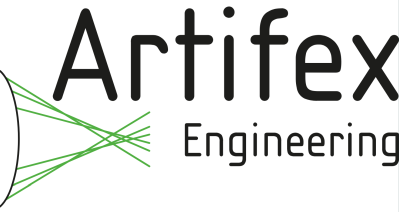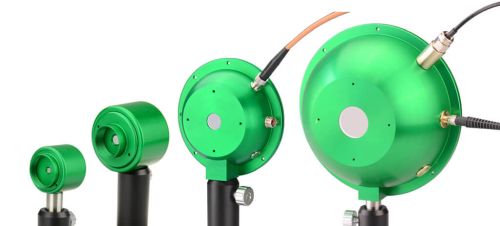integrating spheres (original) (raw)
Definition: devices with a diffusely reflecting inner surface, used for certain optical measurements
Alternative term: Ulbricht spheres
Categories:  photonic devices,
photonic devices,  optical metrology
optical metrology
Related: photodetectorsphotometers
Page views in 12 months: 1581
DOI: 10.61835/l0v Cite the article: BibTex BibLaTex plain textHTML Link to this page! LinkedIn
Content quality and neutrality are maintained according to our editorial policy.
📦 For purchasing integrating spheres, use the RP Photonics Buyer's Guide — an expert-curated directory for finding all relevant suppliers, which also offers advanced purchasing assistance.
What are Integrating Spheres?
An integrating sphere (also called Ulbricht sphere after Friedrich Ulbricht) is an optical device for various purposes such as
- measuring the radiant flux (optical power) from a laser diode, light-emitting diode (LED) or bulb
- measuring the transmittance or reflectance of optical components, even when they partly scatter the light
- illuminating some device very uniformly
- creating accurately defined color mixes (mostly in colorimetry)
- depolarization of light

Figure 1: Integrating sphere for measuring optical powers independent of the spatial beam properties.
An integrating sphere for optical power measurements (see Fig. 1) is a hollow sphere with a diffusely reflecting (scattering) internal surface, typically two or more small openings (ports) for introducing light or attaching a photodetector, and often some so-called baffles, which are light barriers used to prevent direct illumination of a detector by a light source. The arrangement causes many diffuse reflections of the introduced light before it reaches a detector, so that the light flux becomes very uniform at the detector, and nearly independent of the spatial and polarization properties of the introduced light: the detected radiant flux (optical power) depends only on the total introduced power. In that way, the total output power of a light source can be measured, even if the beam divergence is fairly large. Such a device, consisting of an integrating sphere and a photodetector, is called an integrating sphere photometer.
Under certain simplifying assumptions, such as Lambertian scattering characteristics of the inner sphere surface with a uniform reflectivity ($\rho$) and a negligible fraction of the sphere surface covered with ports or other obstructions, the irradiance obtained at a small output port can be calculated as E = \frac{\Phi }{{4\pi {R^2}}}\;\frac{\rho }{{1 - \rho }}$$
where ($\Phi$) is the radiant flux injected through another port. The ($\rho$)-dependent second term can become quite large in cases with high reflectivity, e.g. 99 for ($\rho$) = 0.99. This is essentially because of a large number of reflections of light in such situations. However, the more closely ($\rho$) approaches unity, the larger is the influence of the ports, i.e., the less accurate the estimate is.
Apart from such measurement purposes, an integrating sphere can be used to illuminate a device very uniformly. This can be important e.g. for testing the homogeneity of digital imaging equipment (e.g. CCD arrays).
Ideally, the coating on the inner side of the integrating sphere has a very high reflectivity over the required wavelength range, and the reflection is very diffuse. If the optical losses in the sphere and through the small ports are low, the multiple reflections can lead to a fairly high optical intensity inside the sphere and consequently to a high optical efficiency, even if the sphere is much larger than the light source and the detector.
Spheres with rather different sizes are available. The larger ones may offer more and/or larger output ports, and there are even versions which can handle very high optical powers in the multi-kilowatt region, suitable for measurements on high-power lasers.
Frequently Asked Questions
What is an integrating sphere?
An integrating sphere, also known as an Ulbricht sphere, is a hollow optical component with a highly reflective and diffusing inner surface. It is used for various purposes like measuring optical power, characterizing material reflectance and transmittance, and creating uniform light sources.
How does an integrating sphere work for power measurements?
Light entering the sphere undergoes many diffuse reflections on the inner surface. This process thoroughly homogenizes the light, so that the power measured by a photodetector becomes nearly independent of the input beam's spatial profile, direction, and polarization state.
What are the main applications of integrating spheres?
Key applications include measuring the total radiant flux from light sources like LEDs and lasers, determining the transmittance or reflectance of scattering samples, providing highly uniform illumination for testing imaging sensors, and for depolarization of light.
What is an integrating sphere photometer?
An integrating sphere photometer is a complete measurement device consisting of an integrating sphere combined with a calibrated photodetector. It is designed to measure the total optical power of a light source.
Why is the inner coating of an integrating sphere important?
The inner coating must be highly reflective to ensure that light undergoes many reflections, which leads to high optical throughput and uniform light distribution. The coating's diffuse (Lambertian) scattering characteristic is crucial for homogenizing the light.
Suppliers
Sponsored content: The RP Photonics Buyer's Guide contains 26 suppliers for integrating spheres. Among them:
⚙ hardware
Artifex Engineering manufactures high quality polymer and gold integrating spheres for laser applications. These spheres can be combined with our optical power meters to realize high power measurement units. High power measurements are often performed using thermopile detectors. Thermopiles however, have the disadvantage of reacting very slowly — typical risetimes leading to measurement periods of 1 second at best. The combination of an integrating sphere and a photodiode based power meter opens the possibility of measuring high power fluctuations on a microsecond time scale.
⚙ hardware
AMS Technologies offers a series of general-purpose integrating spheres with 3 or 4 ports. Out of a broad range of models, choose your sphere by selecting size, ports, and reflectance material/coatings. Three durable and highly stable coating options combine a highly reflective surface with nearly perfect Lambertian reflectance.
Interchangeable accessories like light sources, assemblies or port reducers allow for an endless number of application-specific solutions:
- sturdy port frames
- easy-access mounting options
- quick-change accessory options
- dedicated calibration software
- starter kits available, conveniently packaged with the most common port accessories, adapters, and integrating sphere mounting components
⚙ hardware🧩 accessories and parts🔧 maintenance, repair📏 metrology, calibration, testing💡 consulting🧰 development🎓 training💻 software
The right integrating sphere for every application: Instrument Systems manufactures high quality spheres (50–2000 mm) in Berlin and Munich with barium sulfate or PTFE coatings to meet diverse technology and customer requirements:
- The ISP series (barium sulfate) delivers up to 97% reflectance for precise LED and SSL measurements in the visible range.
- PTFE coated spheres (50–250 mm) ensure high throughput from 200 nm to 2500 nm for UV/IR LEDs.
- For automotive and traffic lighting characterization, the Optronik ITS line offers flexible lamp mounting and three burning positions for comprehensive luminous flux, quality control and diffuse transmission/reflection testing.
⚙ hardware
Our general purpose integrating sphere systems are designed to spatially integrate radiant flux in order to measure optical radiation. They can be coupled with a sensor to create radiometers, photometers, or spectroradiometers in order to measure the total geometric flux emanating from a light source or the flux density of an illuminated area. Additionally, these sphere systems can be used to measure the output of high power lasers and laser diodes or to measure the reflectance and transmittance of materials.
Questions and Comments from Users
Here you can submit questions and comments. As far as they get accepted by the author, they will appear above this paragraph together with the author’s answer. The author will decide on acceptance based on certain criteria. Essentially, the issue must be of sufficiently broad interest.
Please do not enter personal data here. (See also our privacy declaration.) If you wish to receive personal feedback or consultancy from the author, please contact him, e.g. via e-mail.
By submitting the information, you give your consent to the potential publication of your inputs on our website according to our rules. (If you later retract your consent, we will delete those inputs.) As your inputs are first reviewed by the author, they may be published with some delay.







